The Microsoft Surface Pro 6 Review: More Than A Color
by Brett Howse on October 16, 2018 3:01 AM EST- Posted in
- Laptops
- Microsoft
- Surface
- Tablets
- Surface Pro
- Surface Pro 6
GPU Performance
While many will lament the loss of the Intel Iris graphics on this year’s lineup of Surface Pro computers, as already stated, there’s no Iris graphics available anymore in the 15-Watt lineup. There’s no doubt that the extra execution units, and the extra eDRAM as a system cache were valuable, but you can’t sell a product that doesn’t exist. As such both the Core i5 and i7 models have the Intel UHD 620 GPU for 2018. Whether or not this will make a dramatic impact on real-world use will depend heavily on what the GPU was used for, since in some cases the wider GPU could made a noticeable impact, but often it was highly thermally limited in a 15-Watt package anyway.
To test GPU performance, the Surface Pro 6 was run through our non-gaming GPU suite. If you’d like to compare it to any other device we’ve tested, please use our online Laptop Bench.
3DMark
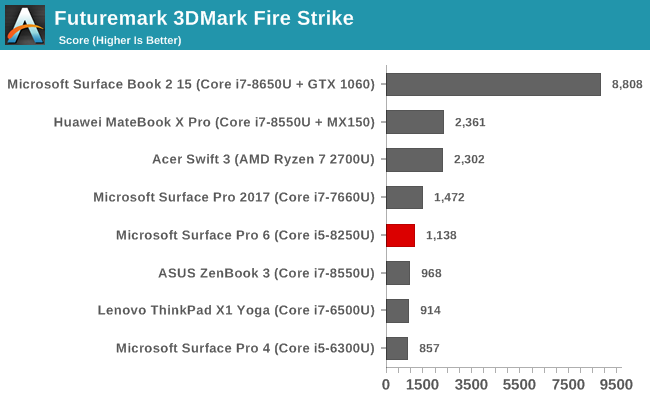
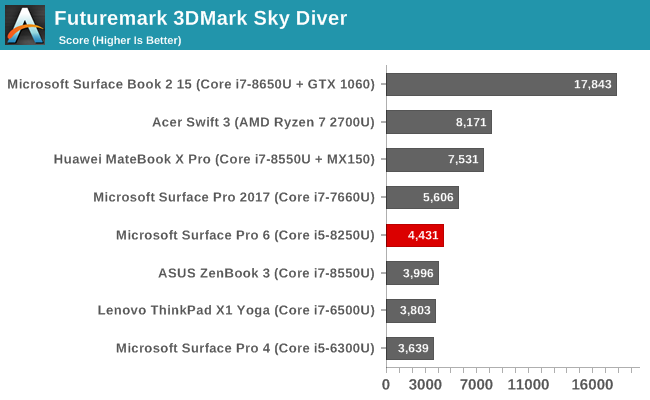
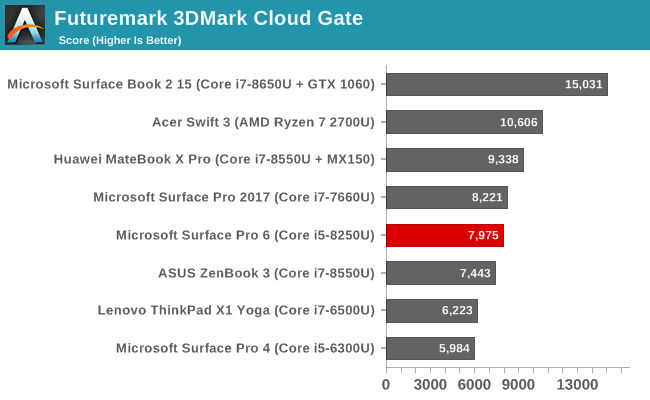
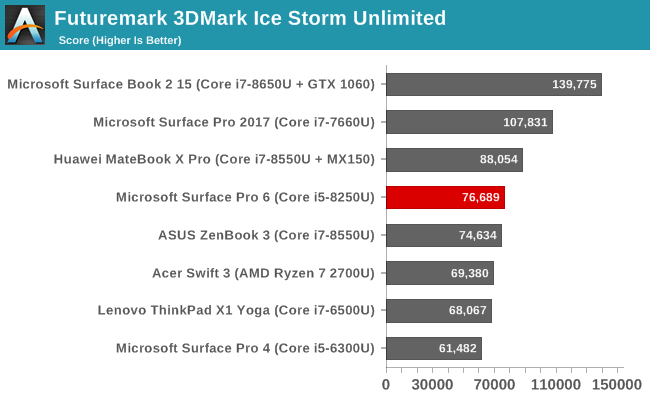
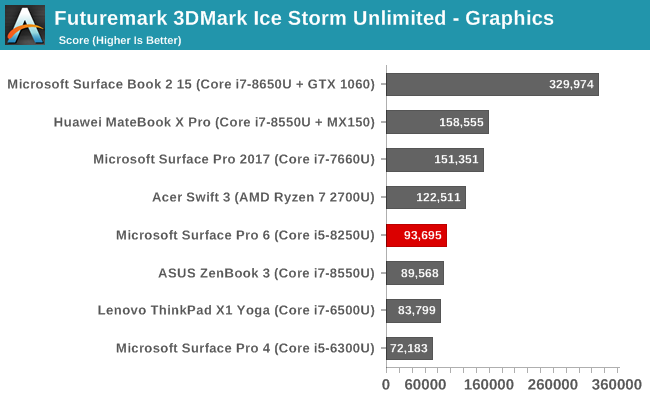
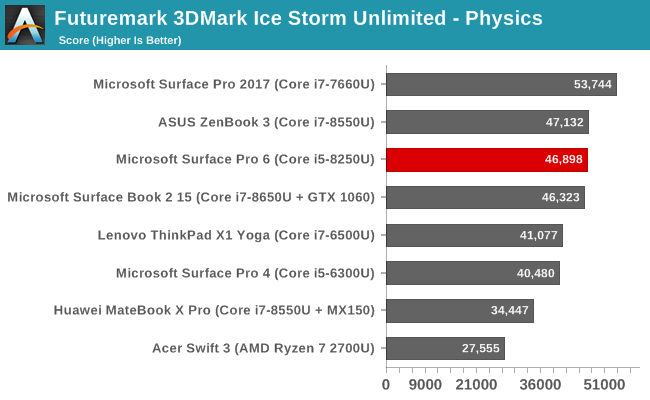
In the synthetic 3DMark from UL Benchmarks, the Surface Pro 6’s extra CPU grunt helps it stay with the Iris equipped 2017 Surface Pro except in the least demanding tests, although on the most demanding GPU test, which is Fire Strike, the UHD 620 is well behind AMD’s Ryzen 7 in the same 15-Watt package.
GFXBench
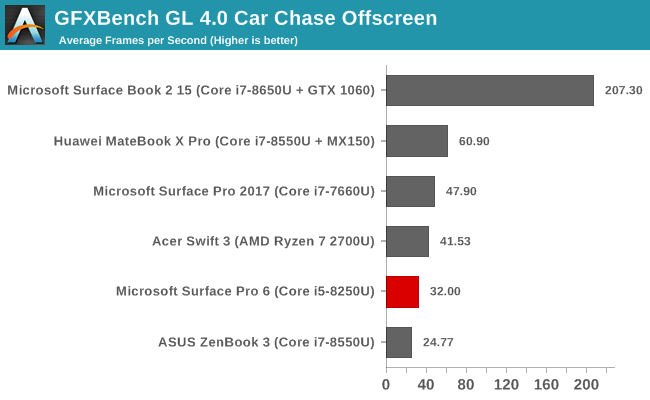

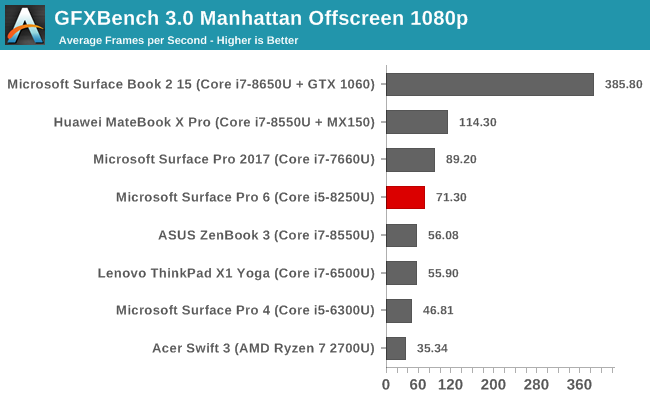

GFXBench is an OpenGL based test and is less relevant due to the lack of new OpenGL titles. These tests are aimed at the mobile computing crowd for smartphones and tablets, although in those cases the tests are run in 16-bit mode and not necessarily in OpenGL either so the results aren’t directly comparable. Here again we see the Surface Pro 6 in the middle of the pack, although the AMD based system drops off due to OpenGL drivers.
Dota 2
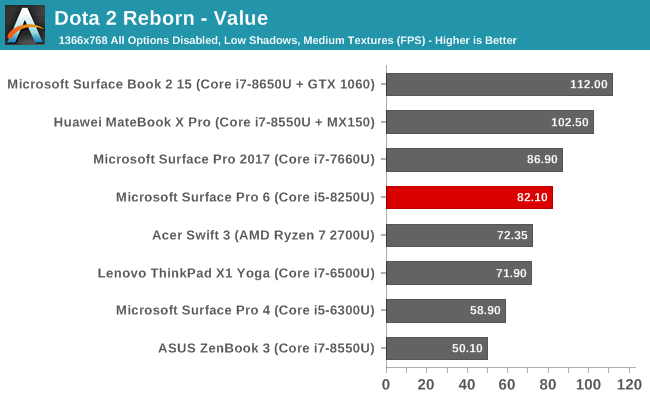
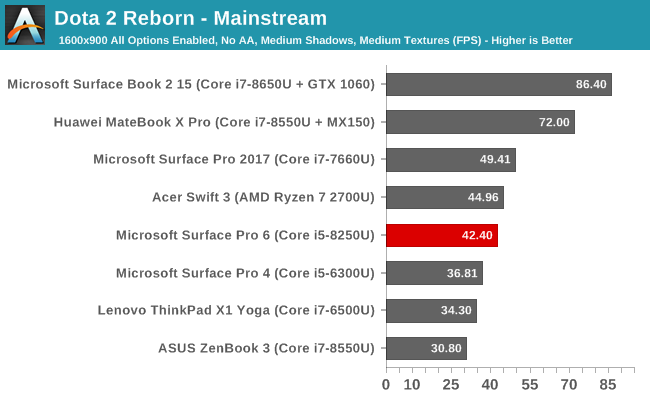

Valve’s Dota 2 is a very popular arena battle game, and the game itself is playable on a wide-range of devices. The game engine tends to be CPU bound quite quickly, but is still a good yardstick when looking at lower-power GPUs. Here the Surface Pro 6 does quite well, especially on the lower detail settings. When the game is set to its maximum settings at 1920x1080, the Iris GPU in last year’s Surface Pro ends up throttling heavily and offering lower performance despite being a quicker GPU on paper. You can see quite easily how the game ends up CPU bound though if you look at the Surface Book 2 which features an NVIDIA GTX 1060 GPU. This GPU will easily run circles around anything else in the charts, but the game is held back by the U series processor.
GPU Conclusion
Intel hasn’t made significant changes to its GPU lineup for some time, and definitely lags behind AMD’s Vega architecture found in the Ryzen mobile lineup. Due to the lack of availability, Microsoft was unable to maintain the tradition of offering the Iris GPU either. We’re fairly accustomed to where the Intel iGPU sits and until a new one is launched, we aren’t going to see anything too dramatic in the GPU performance.
Storage Performance
As with last year’s model, the Surface Pro 6 uses a BGA SSD meaning it’s soldered directly onto the motherboard. This saves space, as well as a couple of grams of weight, compared to the M.2 versions. SSDs have become a commodity, so generally manufacturers tend to buy from several suppliers. We can’t say for sure whether Microsoft is doing that this time, since we just have the single sample, but in the past they have so it would not be surprising to see this multi-sourced.
In the review unit we have the SK Hynix BC501 in a 256 GB configuration. This is a PCIe Gen 3 x2 SSD, which SK Hynix rates for 110K IOPS random read and 150K IOPS random write.
The SSD is bumping into the limits of PCIe 3.0 x2 on sequential read and write, and only the 128 GB model won’t do that according to SK Hynix. As usual, larger SSDs offer better performance, but you’re not going to see higher sequential reads than this BGA SSD offers in a x2 configuration.


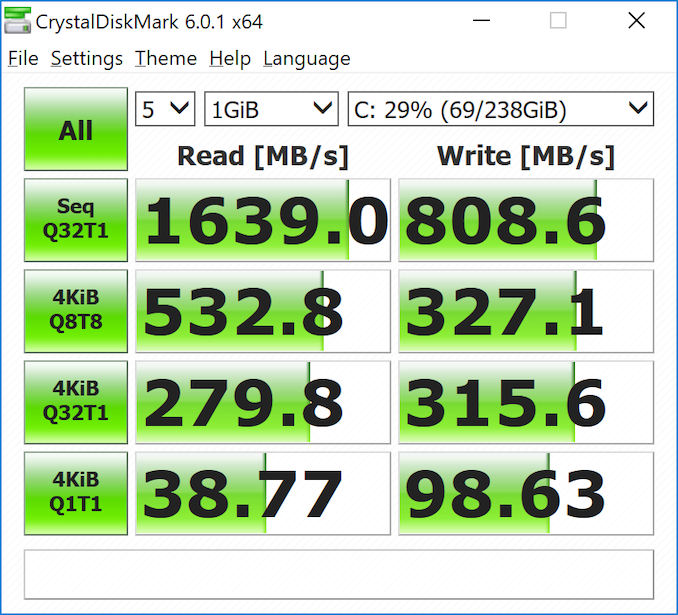








80 Comments
View All Comments
sorten - Tuesday, October 16, 2018 - link
And to think that the only reason I have a SP4 instead of a SP3 is that I was holding out for a USB-C port! It would have been fairly early to market at that point. Looks like I made a great decision.damianrobertjones - Tuesday, October 16, 2018 - link
Tell me... what would you use that port for? You can do it... you can hold out for the Surface pro 3.You could always try the 'Surface Connect to USB-C Adapter'?
Heck wouldn't it be great to run USB c raid arrays with this? No.
Heck wouldn't it be great to have an external GPU with this? No, how much money do you have!?
Heck wouldn't it be great to have a fast usb C thumb drive? No, USB 3.1 drives are still selling lots.
Heck wouldn't it be great to have HDR?
Oh, here we go, the next excuse.
drew805 - Tuesday, October 16, 2018 - link
The main draw of the Type C is that I can charge my laptop and phone with the same charger (and even power my 2in1 with a mobile power pack with USB-PD). I fail to see how a more future proof port that already offers display out capacities is worse than the mini-DP in the SP5. Also, while External GPU's via Thunderbolt 3 are expensive, it is cheaper than building a complete desktop just to get a similar (or likely better) experience. Why is more choice bad?damianrobertjones - Wednesday, October 17, 2018 - link
It's not bad, at all, but the quality on the USB C chargers is startling. Same with the docks. Plus it's another change to overcharge for something that should realistically be cheap. While all of the printers, scanners, mice, keyboards and thumb drives are still USB, USB C can just wait.Plus there's always the MS adapter. People are probably not aware of that.
desolation0 - Wednesday, October 17, 2018 - link
Usb-c and usb-a ports aren't exactly mutually exclusive. We can pretty easily have both simple backwards compatibility and future proofing in the same model. Meanwhile the future proofing option offers obvious and significant utility opportunities that are just not available on the previous generation spec. To skip it on a flagship device when the tech has been available for years and is now being used by pretty much all of the competition even down to mainstream pricing levels seems like a significant oversight.digiguy - Tuesday, October 16, 2018 - link
Brett, I think you are underestimating the difference between the 2017 i5 and i7 in battery life. I have seen reports of over one hour more battery like in the fanless i5. So I don't think battery like in the 2018 model has improved much or at all. Once we have some direct i5 to i5 comparisons (eg. from notebookcheck) we'll be able to see if there is any improvement worth mentioning.OCedHrt - Tuesday, October 16, 2018 - link
The black levels on surface 6 and 4 are the same?Brett Howse - Wednesday, October 17, 2018 - link
Yes and the display is 100 nits brighter so being able to reproduce the same black level with a white that's 100 nits brighter is a sizeable improvement.evilspoons - Tuesday, October 16, 2018 - link
Argggh, I hate that Avastar wireless card so much. I have a Surface Pro 3 and it posts decent 802.11ac speeds for when the SP3 was new... most of the time... but sometimes it just decides to screw up and slow down by like 90%. Copying files over the network, wired gigabit to wired gigabit PC? 60 MB/sec, forever. 802.11ac adapter in my dad's laptop? 40 MB/s. That damn Avastar? 30 MB/s, until it decides to screw up, then 2.5! Yay!Holliday75 - Wednesday, October 17, 2018 - link
Yeah my SP3 is slower than shit on my WiFi. Usually get around 22-25MB/s. I had to force it to 5.2ghz to get those speeds.